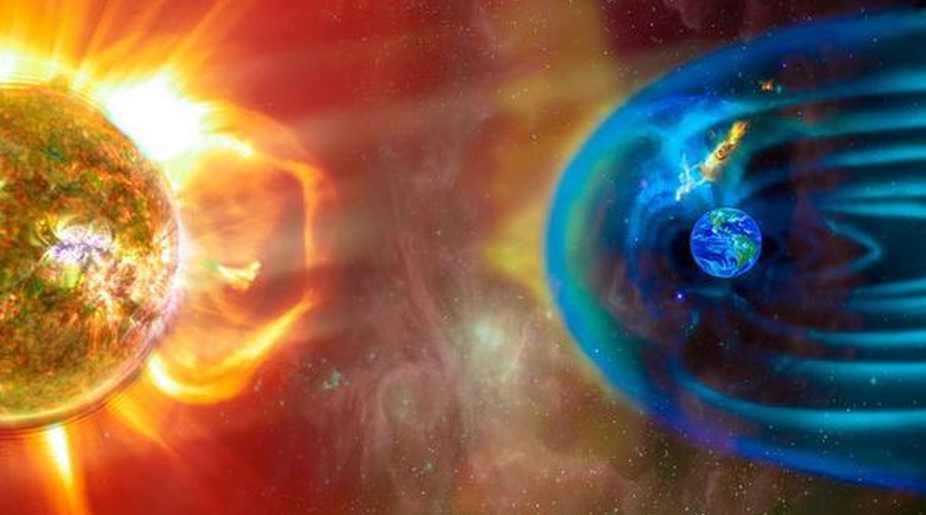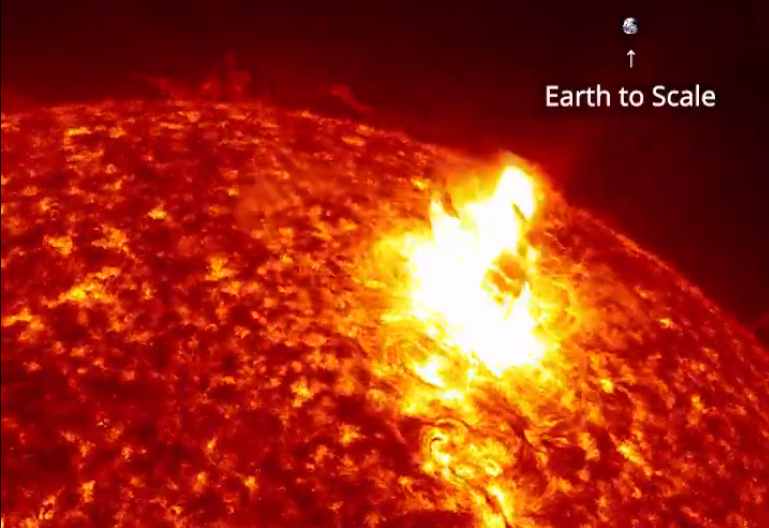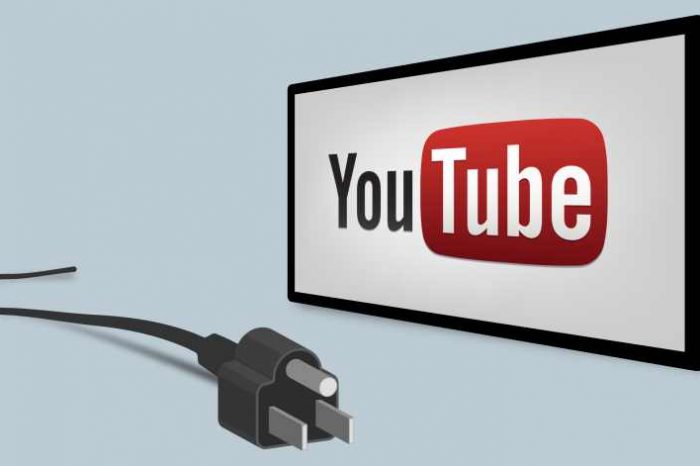New study warns humanity: Rare solar superstorm could cause ‘internet apocalypse’ and global outages that could last for several months

In September 1859, the first recorded solar storm, also known as a Coronal Mass Ejection (CME), hit the United States. Known as the Carrington Event, the solar storm caused widespread telegraph problems. If the same Carrington-scale event were to hit the United States today, Scientists estimate a loss of power for 20 million to 40 million people for as long as two years. This would cost anywhere between $600 billion and $2.6 trillion, not even accounting for internet loss.
Fast forward 162 years later, a new research study out of the University of California Irvine warns that a “black swan” event of a solar superstorm directed at earth could prompt an “internet apocalypse” across the entire globe that could last for several months.
The study was led by University of California Irvine assistant professor Sangeetha Abdu Jyothi, the paper warned that humanity needs to prepare its internet infrastructure for future solar storms or risk a crippling global communication outage. In the paper, Professor Jyothi and his team of researchers analyze the threat posed by solar superstorms to the Internet infrastructure and the steps to be taken to mitigate its effects.
If Professor Jyothi is correct, an unexpected solar event has the capacity to knock out the world’s internet and cause global damage to the world’s critical infrastructure with monumental costs and unforeseen consequences, which could result in what she described as an “internet apocalypse.”
The paper titled, “Solar Superstorms: Planning for an Internet Apocalypse,” was presented last month during the Association for Computing Machinery’s annual conference for their Special Interest Group on Data Communication (SIGCOMM). “One of the greatest dangers facing the internet with the potential for global impact is a powerful solar superstorm,” Professor Jyothi wrote.
“Although humans are protected from these storms by the earth’s magnetic field and atmosphere, they can cause significant damage to man-made infrastructure. The scientific community is generally aware of this threat with modeling efforts and precautionary measures being taken, particularly in the context of power grids. However, the networking community has largely overlooked this risk during the design of the network topology and geo-distributed systems such as DNS and data centers,” he added.
A solar storm, also known as a Coronal Mass Ejection (CME), occurs when a large mass of plasma and highly magnetized particles violently eject from the sun. We wrote about CME back in June. Large CME’s can contain up to a billion tons of matter and can get accelerated to large fractions of the speed of light. You can also watch a video of the coronal mass ejection as it erupted near the surface of the sun and ripple through our solar system.
Every so often, the sun erupted, and releases a significant amount of plasma and accompanying magnetic field with the power of 20 million nuclear bombs from the sun’s corona. These expulsions are known as coronal mass ejections or CMEs. These eruptions send over a billion tons of matter flying through space impacting any planets or spacecraft in its path and send shocks ripple through the solar system, which ultimately may interrupt satellites and power grids on Earth.
When the sun is most active, the CMEs non can happen several times a day. However, during its quieter periods, CMEs occur only about once every five days. Large CME’s can contain up to a billion tons of matter and can get accelerated to large fractions of the speed of light.

What will happen if there is a global Internet collapse?
Professor Jyothi said that a disruption lasting even a few minutes can lead to huge losses for service providers and damages in cyber-physical systems. The economic impact of an Internet disruption for a day in the US is estimated to be over $7 billion An extended and global outage would cost much more, Professor Jyothi added.
He went to paint a more dire scenario of what would happen if the internet is disrupted for days or even months? “This is the worst-case scenario, which, fortunately, we have never encountered in recent history. Threats to the Internet range from man-made cyber attacks to natural disasters such as earthquakes. The Internet is also affected by black swan events such as the Covid-19, which profoundly alter human lives and, in turn, our Internet usage. However, the in#uence of these indirect threats on the Internet is only secondary, with the worst-case impact often limited to reduced speeds,” Professor Jyothi wrote.
Professor Jyothi went on to say that, power grids, oil and gas pipelines, and networking cables are the most vulnerable to the impacts of geomagnetically induced currents (GICs), while submarine cables, which span hundreds or thousands of kilometres, are even more vulnerable than land cables, due to their larger lengths.
Due to lack of real-world data on the impacts of GIC’s on these submarine cables, researchers still don’t know how long it would take to repair them if such an event were to occur, and—just like natural disasters such as earthquakes—CME’s are extremely difficult for scientists to predict.
The paper further noted that the “distribution of internet infrastructure is skewed when compared to the distribution of internet users,” and high-latitude climates are more at risk if a solar storm were to occur.
“The U.S. is one of the most vulnerable locations with a high risk of disconnection from Europe during extreme solar events. Intra-continental connections in Europe are at a lower risk due to the presence of a large number of shorter land and submarine cables interconnecting the continent,” the study says.
Some countries are safer than others
In the event severe solar superstorms were to happen, Professor Jyothi said a country like Singapore would maintain good connectivity to neighboring countries, while cities in China would be more likely to lose connectivity than India because China connects to much longer cables. Australia, New Zealand, and other island countries in the region would be at high risk of losing most of their long-distance connections.
The research warns that a collapse of the internet—even one lasting a few minutes—could cause devastating losses to service providers and damage cyber-physical systems. The economic impact of an internet disruption for a day in the United States is estimated to be over $7 billion.
While the likelihood of a solar superstorm hitting the earth is rare—with astrophysicists noting that the probability of extreme space weather events that directly impact earth occurring is between 1.6 percent to 12 percent per decade—they can still happen.
What can be done to prevent damage
It’s not all gloom and doom. Professor Jyothi highlighted
A prominent issue in our current setup is the location of internet infrastructure. With the increasing melting of Arctic ice, more and more cables are being put at higher latitudes. While this improves latency, it also puts the cables in areas more likely to suffer during solar storms.
Because of this, Abdu Jyothi recommended putting internet cables in Central and South America to ensure connectivity in the event of a solar storm. A warning system could also mitigate damage. Solar storms take some time – between 13 hours and three days – to reach the Earth. By powering off infrastructure temporarily, it could provide limited protection to systems.
The paper concludes with the following, “Paying attention to this threat and planning defenses against it is critical for the long-term resilience of the Internet.”
“In this paper, we show that a powerful solar superstorm has the potential to cause massive disruption of the Internet. Astrophysicists estimate the likelihood of a solar storm of su$cient strength to cause catastrophic disruption occurring within the next decade to be 1.6 12%. Paying attention to this threat and planning defenses against it, like our preliminary effort in this paper, is critical for the long-term resilience of the Internet. Several challenges remain open in this space. How can we model infrastructure failures more accurately? How do we factor in solar threat during Internet infrastructure and systems design? How can we help operators in making disaster preparation and recovery plans? We anticipate that this paper will provide an initial impetus towards answering these important questions.”
Below is a video of how solar storms could destroy civilization.
You can also read the research study below.
sigcomm21-cme

